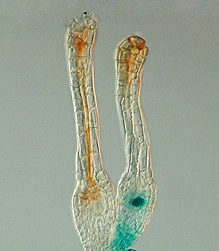Polycomb-group proteins
Polycomb-group proteins (PcG proteins) are a
In insects
In
In mammals
In mammals Polycomb Group gene expression is important in many aspects of development like
Regulation of Polycomb-group proteins at bivalent chromatin sites is performed by SWI/SNF complexes, which oppose the accumulation of Polycomb complexes through ATP-dependent eviction.[8]
In plants
In Physcomitrella patens the PcG protein FIE is specifically expressed in stem cells such as the unfertilized egg cell. Soon after fertilisation the FIE gene is inactivated in the young embryo.[9] The Polycomb gene FIE is expressed in unfertilised egg cells of the moss Physcomitrella patens and expression ceases after fertilisation in the developing diploid sporophyte.
It has been shown that unlike in mammals the PcG are necessary to keep the cells in a differentiated state. Consequently, loss of PcG causes de-differentiation and promotes embryonic development.[10]
Polycomb-group proteins also intervene in the control of flowering by silencing the Flowering Locus C gene.[11] This gene is a central part of the pathway that inhibits flowering in plants and its silencing during winter is suspected to be one of the main factors intervening in plant vernalization.[12]

See also
- PRC1
- PRC2
- PHC1
- PHC2
- Heterochromatin protein 1 (Cbx)
- BMI1
- PCGF1, KDM2B
- PCGF2 (Polycomb group RING finger protein 2) ortolog Bmi1
- RYBP
- RING1
- SUV39H1 (histone-lysine N-methyltransferase)
- L3mbtl2
- EZH2 (Enhancer of Zeste Homolog 2)
- EED
- SUZ12 (Suppressor of Zeste 12)
- Jarid2(jumonji, AT rich interactive domain 2)
- RE1-silencing transcription factor (REST)
- RNF2
- CBFβ
- YY1
- Bivalent chromatin
References
- ISBN 978-1-904455-25-7.
- PMID 18974828.
- ^ Heurtier, V., Owens, N., Gonzalez, I. et al. The molecular logic of Nanog-induced self-renewal in mouse embryonic stem cells. Nat Commun 10, 1109 (2019). https://doi.org/10.1038/s41467-019-09041-z
- ^ PMID 15964994.
- PMID 14722607.
- PMID 18447587.
- PMID 20716961.
- PMID 27941795.
- PMID 19542356.
- PMID 19680533.
- PMID 18852898.
- PMID 10716723.
Further reading
- Schuettengruber B, Bourbon HM, Di Croce L, Cavalli G (September 2017). "Genome Regulation by Polycomb and Trithorax: 70 Years and Counting" (PDF). Cell. 171 (1): 34–57. S2CID 43165761.
- Di Croce L, Helin K (2013). "Transcriptional regulation by Polycomb group proteins". Nature Structural & Molecular Biology. 20 (10): 1147–55. S2CID 2681793.
- Simon JA, Kingston RE (2013). "Occupying chromatin: Polycomb mechanisms for getting to genomic targets, stopping transcriptional traffic, and staying put". Molecular Cell. 49 (5): 808–24. PMID 23473600.
- Golbabapour S, Majid NA, Hassandarvish P, Hajrezaie M, Abdulla MA, Hadi AH (2013). "Gene silencing and Polycomb group proteins: an overview of their structure, mechanisms and phylogenetics". OMICS: A Journal of Integrative Biology. 17 (6): 283–96. PMID 23692361.
- Schwartz YB, Pirrotta V (January 2007). "Polycomb silencing mechanisms and the management of genomic programmes". Nature Reviews. Genetics. 8 (1): 9–22. S2CID 28227227.
- Schuettengruber B, Chourrout D, Vervoort M, Leblanc B, Cavalli G (February 2007). "Genome regulation by polycomb and trithorax proteins". Cell. 128 (4): 735–45. S2CID 6492075.
- Pirrotta V, Li HB (2012). "A view of nuclear Polycomb bodies". Current Opinion in Genetics & Development. 22 (2): 101–9. PMID 22178420.
External links
- "polycomb group proteins". Humpath.com.
- The Polycomb and Trithorax page of the Cavalli lab This page contains useful information on Polycomb and trithorax proteins, in the form of an introduction, links to published reviews, list of Polycomb and trithorax proteins, illustrative power point slides and a link to a genome browser showing the genome-wide distribution of these proteins in Drosophila melanogaster.
- Drosophila Genes in Development: Polycomb-group in the Homeobox Genes DataBase
- Chromatin organization and the Polycomb and Trithorax groups in The Interactive Fly
- polycomb+group+proteins at the U.S. National Library of Medicine Medical Subject Headings (MeSH)
